Social Distancing in Your Backyard
BY BRENDA STUART | APRIL 14TH, 2020 | BLOG, HOME & GARDENHow a Modern-Day ‘Victory Garden’ Can Help You Through the Coronavirus Pandemic
As the coronavirus pandemic progresses, a growing number of state governments are requiring people to stay at home and make only minimal trips to stores for necessities. Besides making sure their households have enough hand soap and sanitizer, people are also trying to lay in enough food, water, medicine, disinfectants, and other supplies to last for several weeks of self-isolation.
During uncertain times like these, it’s natural to wonder whether you could practice social distancing and simultaneously minimize your long-term dependency on the grocery store by growing food and natural remedies in your own backyard. The answer is yes — with plenty of planning, effort, and time (which, if you’re stuck at home, you’ll have more of than usual). Here are things to think about, plus tips for preparing, planting, and maintaining a garden that can help you survive an emergency.
Survival Gardening: What Is It? Why Is It a Good Idea?
You don’t have to become a full-blown prepper or try to survive exclusively off the land. Think of it more like the victory gardens your grandparents or great-grandparents may have planted. You can grow some herbs and vegetables in pots on a balcony or convert a large portion of your yard to staple crops, or anything in between. Either way:
- You can save money and unnecessary trips to the grocery store by supplementing your food supply with healthy, homegrown produce. And you’ll also have food you enjoy in case there are shortages.
- You can grow and make your own home remedies in case over-the-counter medicines become scarce or you’d rather not venture out to procure them.
- Social distancing is easier when you don’t need to go out and encounter people as often.
- There are psychological and physical benefits to getting outdoors for family members of all ages.
- Gardening is a great way to spend lockdown time that might otherwise make you stir-crazy. Enlist your kids in the project and take the opportunity to help them work off some pent-up energy — while introducing some homeschool-type lessons on topics ranging from geometry to physical education to biology.
Who Can Make a ‘Survival’ or ‘Victory’ Garden?
Anyone! Obviously, the space you have and the time you’re willing to spend will determine the scale. Few people can completely support themselves, especially right away — but anything you grow helps your budget and saves a trip to the store.
Especially if you’re new to the gardening game, it can help to:
- Set realistic expectations for your time, space, and other resources. Ask yourself: Should this be a small, medium, or large operation? How much space do I have? How much time and energy can I spend on planning, planting, watering, weeding, etc.?
- Start small. First-time gardening involves a learning curve, so take baby steps if you’ve never gardened before. Begin with a potted herb like basil or mint, or a medicinal plant such as aloe or marigolds. Definitely plant a few easy-to-grow vegetables, including green beans or potatoes. From there, add new crops as you wish.
Growing Your Own Food: 6 Things You Need to Get Started
1) A plan
If you want good results, you can’t just start sticking plants in the ground. Gardening depends on a lot of factors, and you need to consider them first. (THEN you can start sticking plants in the ground!)
Think about:
- What vegetables you actually like to eat that grow well in your climate, as well as the calorie, protein, and vitamin content of those choices.
- How many people you hope to feed and what you’ll be able to store or preserve.
- Which medicinal herbs and other useful plants you want to grow.
- How and where you’ll grow it all. Indoors or outdoors? in containers, hills, rows, or raised beds? In a greenhouse? Maybe even a hidden garden?
2) Space
The country’s median garden size is about 96 square feet (8 feet by 12 feet). That’s very close to 100 square feet — the ideal size for a summer vegetable garden that can fill the needs of one person.
So, how much food can a space like that yield? One gardener writing for Mother Earth News calculated her 100-square-foot plot’s annual yield at 77.5 pounds of tomatoes, 15.5 pounds of bell peppers, 14.3 pounds of lettuce, 2.5 pounds of basil, and 126 pounds of zucchini!
Also pay attention to the amount of sun and shade your intended plot will get, so you can decide which plants should go where. Lots of gardening websites offer garden planners to help you visualize and design your plot.
3) Water
A clean water supply is important, of course. Unless your area gets a lot of rainfall, you’ll probably be watering from your household water supply by hand, hose, or sprinkler. It’s easy to install a water filter to prevent chlorine, salts, and other chemicals from getting into your soil and your food — there are filters that screw right onto your garden hose!
4) Soil
You’ll also need fertile soil that’s been tilled or loosened and is free of rocks and debris. If you’re converting a yard from turf, turning the soil for the first time will be one of the most time- and labor-intensive steps in the process. Prepare yourself now!
You can learn things about your soil in the process, including its history of pesticide, herbicide, or fertilizer use. You’ll also get to know the consistency of the soil texture — what proportions of sand, silt, clay, or loam it contains — plus how much rock you’ll need to remove.
5) Time
A garden will take up as much time as you give it, but most sources seem to agree that once plants are in the ground and growing, you’ll devote at minimum 5-10 hours per week to planting, watering, weeding, fertilizing, etc.
Also, when starting a survival garden, you probably want the period from planting to harvest to take as little time as possible, so consider sowing some fast-growing plants in your first crop. (See 17 Fastest-Growing Backyard Crops, below, for suggestions.)
6) Tools
There are some basic tools every backyard gardener needs to begin with, including:
- Gardening gloves. They should fit snugly and be thick enough to prevent calluses and protect from thorns.
- Shovel and/or spade. Try breaking ground and digging into soil without them. You won’t like it.
- Trowel. Use this handheld version of a shovel for digging and scooping soil.
- Cultivator. Also called a garden fork or hand rake, use it to break up soil.
- Shears. These small, handheld “garden scissors” are used to cut stems, twigs, vines, etc.
- Rake. It can’t be beat for gathering cuttings and debris, clearing topsoil, etc.
- Garden hose and nozzle. A nozzle helps spread and regulate water flow.
- Watering can. Used for watering in places the hose won’t reach.
Once your garden starts growing and you get a little deeper in, you also might need:
- Loppers. A long-handled tool with scissor-like blades that cuts branches, vines, etc.
- Hoe. This long-handled tool with a flat blade is used for cutting weeds, turning soil.
- Pitchfork. Spread straw or other ground cover with this tined tool.
- Axe and/or hatchet. Cut branches and trunks of larger plants.
- Pruning saw. With this serrated metal blade you can saw off stems, shoots, etc.
- Wheelbarrow Transport soil, plants, tools, and everything else.
Growing Food: Start With Staples
When it comes to selecting crops for a survival garden, everybody has different needs and tastes. Here’s a basic example of the types of staple crops you can plant:
- Root vegetables: beets, carrots, potatoes, parsnips, sweet potatoes.
- Leafy greens: chard, collards, kale, lettuce, spinach.
- Crucifers: bok choy, Brussels sprouts, broccoli, cabbage, cauliflower.
- Legumes: beans or peas, which grow well with corn, squash, zucchini.
- And tomatoes: of course! They’re everybody’s favorite vegetable (that’s really a fruit).
These veggies have different growing seasons, which can allow you to start a few kinds of plants at a time and focus on establishing them before it’s time to get the next crop going. (Just make sure to plan your garden layout with enough room for everybody.) This also means there should be something new that’s ready to harvest throughout most of the year.
There are plenty of different lenses to help you focus your plant choices. You can consider growing time; ease of cultivation; protein, calorie or vitamin content. Luckily, many plants show up on multiple lists and grow well in your area. If you like to eat them (and bonus: if your kids like to eat them), then give them a try in your victory garden!
17 Fastest-Growing Backyard Crops
Remember growing bean sprouts in school? There’s a reason kindergarten teachers everywhere choose them: The seeds sprout and turn in visible results in almost no time.
| Food | Average days from sowing to harvest |
| green onions | 20-30 days |
| radishes | 25 days |
| spinach | 30 days |
| arugula | 30 days |
| carrots | 30-50 days |
| lettuce | 30-45 days |
| summer squash/ zucchini | 35 days |
| bush beans | 60 days |
| bok choy | 45-60 days |
| cucumbers | 50 days |
| beets | greens: 30 days / roots: 50 days |
| okra | 50-55 days |
| kale | 50-65 days |
| snow peas | 60 days |
| broccoli | 60 days |
| turnips | greens: 40 days / roots: 60 days |
Start your first survival garden season with some of these fast-growing crops, and you could be harvesting dinner within a few months.
The Hardest and Easiest Crops to Grow at Home
Some crops are just easier than others. First-timer? You might want to stick with the crops easiest to grow in your area. Got some dirt under your nails? Go for the more finicky varieties.
| Easier-to-grow crops | Harder-to-grow crops |
| cucumbers | arugula |
| garlic | bok choy |
| green beans | broccoli |
| kale | cauliflower |
| lettuce | eggplant |
| peas | mustard greens |
| potatoes | onions |
| radishes* | radishes* |
| summer squash/ zucchini | spinach |
*Wondering why radishes show up on both the easy-to-grow and hard-to-grow lists? Because it’s easy to get radishes sprouted and growing, but not always easy to keep this cool-weather plant from bolting (prematurely flowering and going to seed before producing food) in warm weather. The same is true for many on the hard-to-grow list.
8 Calorie-Rich Survival Garden Crops
If you’re trying to keep your family fed in a crisis situation, calories (boosting them, that is — not cutting them down!) may become more important than you ever thought possible. These are among the most calorie-dense crops you can plant.
| Food | Average calories |
| sunflower seeds | 700 kcals per cup (shelled) |
| avocado | 370 kcals per cup (puréed) |
| soybeans | 300 kcals per cup |
| potatoes | 260 kcals each (medium) |
| lima beans | 210 kcals per cup |
| corn | 130 kcals per ear |
| sweet potatoes | 130 kcals each (medium) |
| pinto beans | 80 kcals per cup |
| Source: USDA Food Data Central |
8 High-Protein Backyard Crops
Protein is also important for maintaining proper health. There are plenty of ways to get protein into your garden and onto your plate.
| Food | Average protein per cup |
| soybeans | 68 grams |
| pumpkin seeds | 36 grams |
| pinto beans | 28 grams |
| quinoa | 24 grams |
| buckwheat | 22 grams |
| peanuts | 16 grams |
| chickpeas | 14 grams |
| broccoli | 2.5 grams |
| Source: USDA Food Data Central |
Besides legumes and grains, many green veggies are high in protein — such as broccoli, which contains more protein per calorie than steak. (You’d just have to eat many more mouthfuls of greens to get the same number of calories as you’d get from the animal products.)
17 Foods You Can Regrow From Kitchen Scraps
A smart way to reduce food waste and get more of the crops you already like to eat is to regrow food from cuttings. This also saves unnecessary trips to the store or garden center. If you’ve never done this before, now is a great time to start. Here are some foods you can regrow.
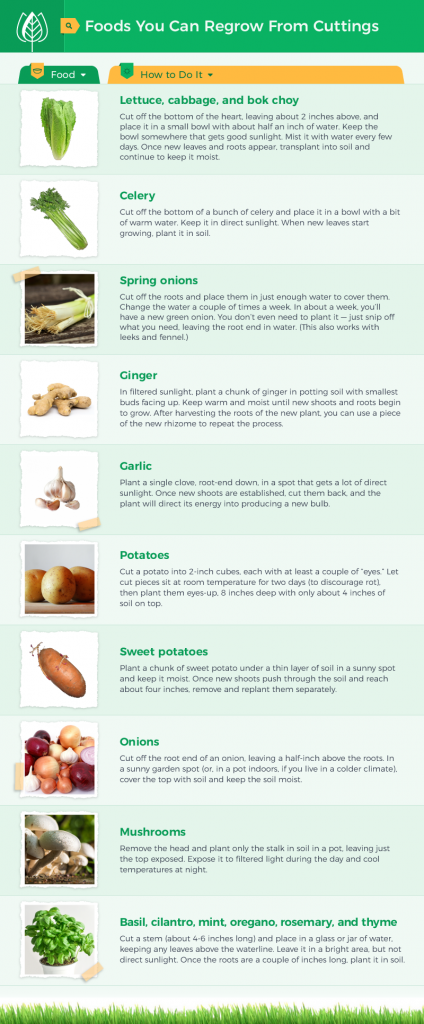
Growing Medicine: Backyard Plants With Healing Properties
Both in the soil and in your home, vegetables in your survival garden will be complemented by other plants. Medicinal herbs can replace store-bought supplements or pharmaceuticals in healing injury and relieving illnesses, and other plants can help you replace household items.
Conditions You Can Treat With Backyard Plants
Self-sufficiency is always a great feeling, but it’s of much greater importance during a crisis. If store-bought pharmaceuticals are unavailable, you might be able to harvest something from the garden to help relieve an injury or malady. These are some conditions that have been treated using medicinal herbs:
- scrapes
- cuts
- bruises
- burns
- insect bites
- itching or irritation
- infection
- swelling/ inflammation
- aches
- pains
- cramps
- fever
- headache
- stomachache
- indigestion
- diarrhea
- sore throat
- cough
- congestion
- trouble breathing
8 Healing Plants You Might Already Have in Your Garden
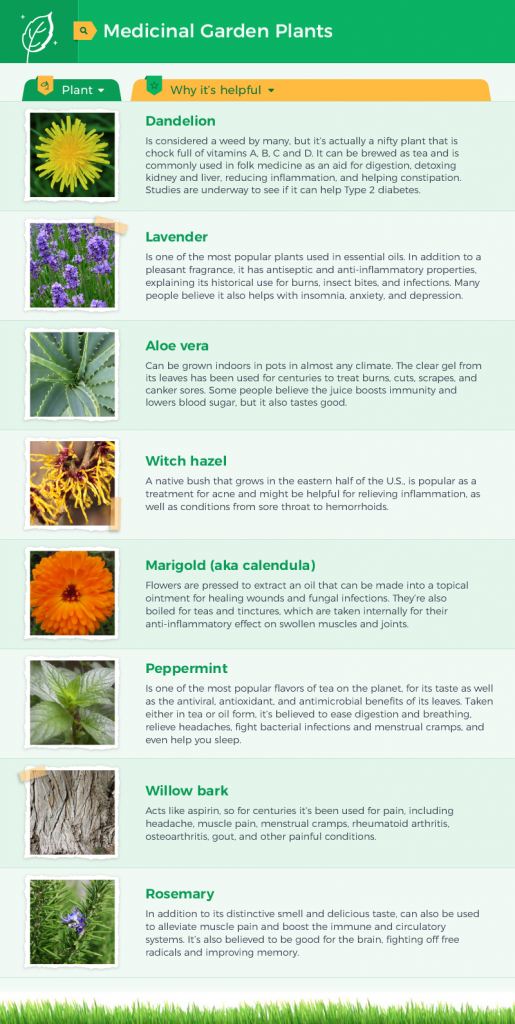
12 Plants to Make Into a Tea
For centuries, people have made tea from the leaves of various plants to relieve certain ailments. Here are some plants that make herbal teas believed to offer health benefits:
- blackberry leaf
- chamomile
- clove
- dandelion
- echinacea
- elderberry
- feverfew
- ginger
- lemon balm
- lemongrass
- mint
- rosehips
6 Plants to Make Into Topical Salves
Because of their natural antiseptic and pain-relieving benefits, these plants can be made into topical applications — oils, ointments, washes, poultices, or salves — to relieve skin irritation, inflammation, or muscular pain, as well as heal cuts, scrapes, bruises, and burns.
- aloe
- arnica
- calendula
- chamomile
- lavender
- witch hazel
11 Poisonous Plants to Be Careful About
Some medicinal plants look like other plants that can be toxic or even deadly, so make sure you pay attention. (And remember: This is by no means a comprehensive list!)
- blue cohosh
- calla lily
- castor bean plant
- belladonna (aka deadly nightshade)
- foxglove
- hemlock
- oleander
- pokeweed
- rosary pea
- white snakeroot
- wolfsbane
Also, some plants have similar names. For example, don’t confuse black cohosh — used for easing menstrual cramps and hot flashes — with blue cohosh, which can cause miscarriage in pregnant women. The raw berries also can cause vomiting and diarrhea in children if ingested.
9 Plants Whose Leaves You Can Use Instead of Toilet Paper
Hopefully, you won’t run out of toilet paper or any of the next-most-useful replacements like tissues, napkins, or paper towels. But if you get to the point of looking for rugged, old-school solutions, leaves are your best bet. Check your backyard. The following trees and plants are good candidates because of the size, softness, thickness, and durability of their leaves. As a bonus, they also generally don’t contain any skin-irritating chemicals.
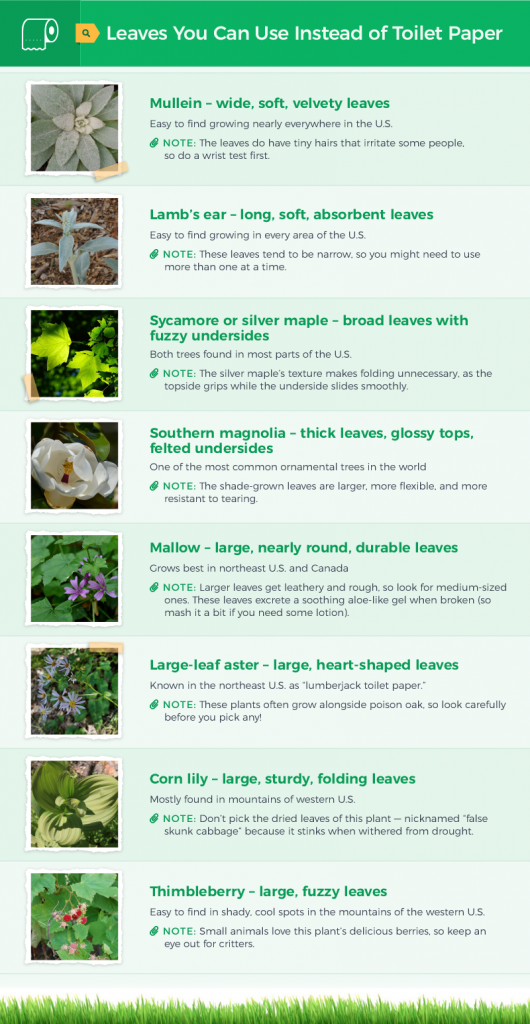
If you don’t already have access to any of these, it might not be a bad idea to plant a few — just in case. Mullein, mallow, lamb’s ear, and asters do well in gardens across the U.S. Corn lily and thimbleberry are mountainous and grow best at higher altitudes. (Remember: It’s important to make sure you know exactly what a plant is before you use it on any part of your body.)
5 Plants You Can Use to Make Rope
Of course you’ve stocked plenty of rope among your supplies. But what happens if it gets lost, stolen, or somehow compromised? You make your own rope, of course — armed with know-how, plenty of time, immense patience, no small amount of labor, and any of these plants.
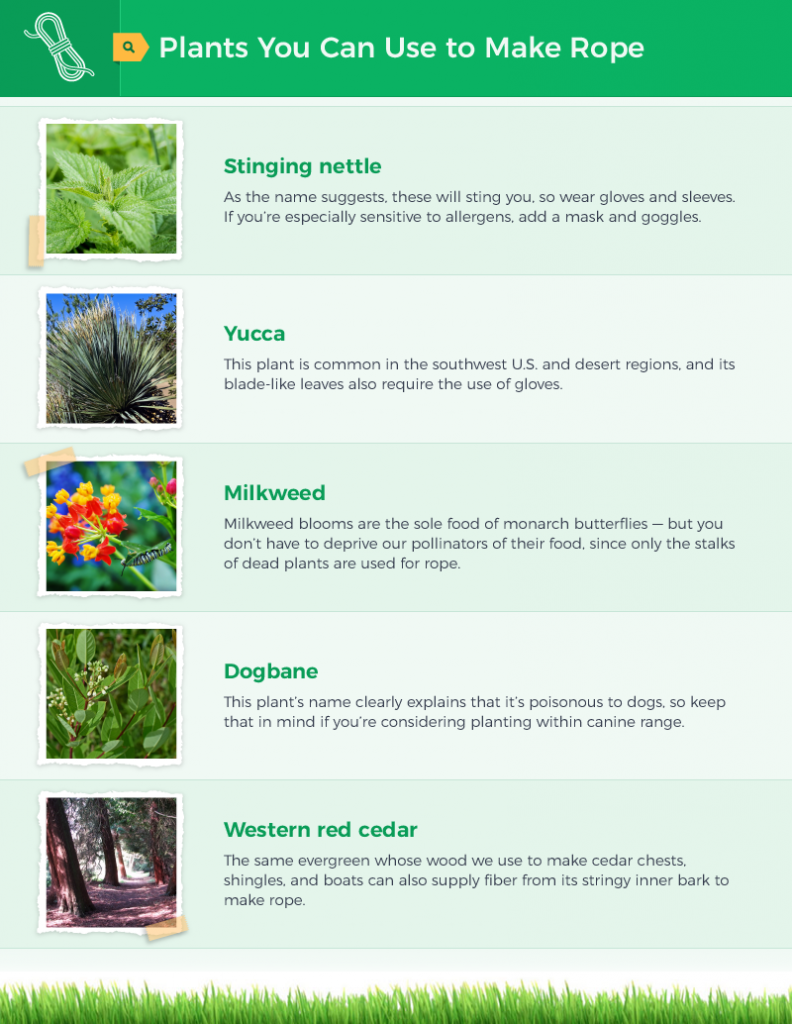
Some of these fibrous plants will work better than others in your garden. Milkweed complements mainstream garden life, encouraging butterflies that help with pollination. Conversely, because of their unfriendly properties, dogbane and stinging nettle require a more out-of-the-way spot.
Be Zone-Savvy: Set Yourself Up for Success by Knowing Your Hardiness Zone
The United States is immense, so there’s no single typical growing season or harvest period. Instead, the U.S. Dept. of Agriculture has designated “plant hardiness zones” to guide planting all across the country. The zones are determined by the lowest winter temperatures (historically averaged) as they occur across the geographic areas of the U.S.
Hardiness zone maps are also accessible by state or by region. Using them to figure out the specific temperature range for your area can help you gauge which plants will grow best and last longest.
Once you know your zone, you can begin to figure out a timetable that will work for gardening in your area. Several websites provide a planting and harvest calendar for each zone, as well as suggestions for vegetables and general planting advice.
Preparing the Soil
Once you’ve decided what to grow and planned where and when to grow it, it’s finally time for the how: Get your hands dirty and dig into the soil!
Designing Your Dirt
Raised beds
One of the most common gardening methods, planting in raised beds involves turning the bed soil, then adding more soil and compost on top. Beds can be contained in boxes where the entire surface is raised, or soil can be formed into mounds or rows above the original surface. A raised-bed design can offer several advantages:
- improved drainage – Gravity draws and spreads water and nutrients down into the soil, where roots can make use of them (rather than letting water pool, which can cause rot).
- warmer temperatures – Soil on top heats up faster, allowing for earlier planting, which is especially great for cooler growing zones.
- better airflow – Looser, fluffier soil lets air in to enhance root growth.
- improved soil composition – Even if your soil quality is poor to begin with, you can add organic soil and compost to make a fine growing medium.
- easier weed control – Tightly spaced plants leave less room for weeds, and looser soil makes them easier to pull.
- bigger yields – Plants in raised beds can be planted closer together, taking advantage of succession planting (different crops throughout the year) and vertical space (see hills, below) to yield more food in a smaller space.
Hills
You’ve heard the expression “doesn’t amount to a hill of beans?” Yep, beans grow best in hills. Planting in hills (or mounds) works well for vining plants like beans, squash, cucumbers, and melons. Often they’re planted with a vertical frame for the vines to climb.
Rows
Traditional gardens planted in rows can be especially useful for supporting large crops like corn, canning tomatoes, potatoes and other produce that takes up a lot of room.
Improving Soil Quality
When your food is coming from it, you want to make sure your soil is as clean, chemical-free, and nutritious as possible. If you or previous land occupants have used pesticides or herbicides in the bed soil, you’ll probably want to make raised beds and add organic soil and compost. After that, adding an annual layer of compost adds nutrients and continually improves the soil.
Fertilizers From the Kitchen
You’re also probably looking for a shorter timeline than it takes for a compost pile to “ripen” for use, so meanwhile, you can divert these classic compost ingredients directly into the soil as DIY fertilizers:
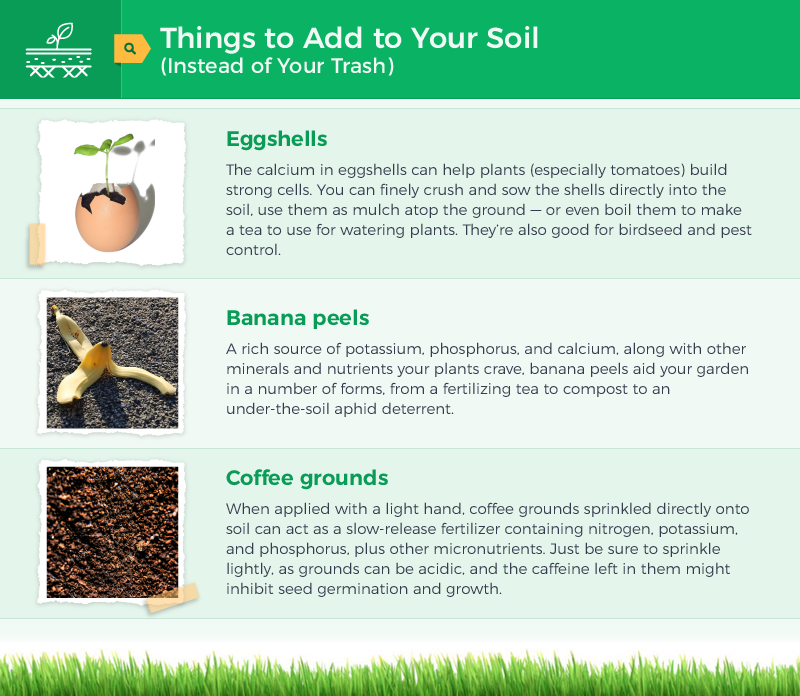
Planting: Should You Use Seeds or Seedlings?
Vegetables and other plants vary in the forms they best grow from: seeds or seedlings. Here’s an overview of each type, plus some advice on getting them started:
Foods That Grow Easily From Seeds
To grow some vegetables, you can just stick a seed in the ground, let it germinate, and cultivate it from there. Easier than cuttings, and cheaper than seedlings! These plants include:
- arugula
- beans
- beets
- carrots
- corn
- cucumber
- lettuce
- peas
- pumpkins
- radishes
- spinach
- squash
The basics of planting seeds, of course, are the much the same as for any type of planting:
- Begin with rich soil that’s not too wet or dry.
- Choose a plot (or pot) that receives adequate sunlight for the seeds you plant (corn, tomatoes, and peppers need full sun, but spinach, lettuce, and other greens like fewer sunny hours).
- Pay attention to the specifications for depth and space that your seeds are known to like. Too deep, and they won’t reach the surface; too shallow, and they won’t stay anchored.
- Water regularly enough to keep the soil moist, but not so much that it feels soppy or looks flooded.
Creative planting tip: Did you know you can sprout seeds in eggshells? Simply take several clean, empty shells, carefully poke a drainage hole in the bottom of each, then set into an egg carton. Fill each shell with some potting soil, sprinkle a few seeds of your choice, then lightly rake a little soil over them. Set in a sunny spot and keep moist with a mister until leaves sprout. Then, you can plant the entire thing into a pot, and the eggshell will fertilize the plant it helped sprout! This can also be done with hollowed-out citrus peels.
Plants That Start Best From Seedlings
Some plants are notoriously hard to germinate from seeds and/or keep alive. Seedlings are more mature and stronger (as well as more pest-resistant) when they’re transplanted, so you’re less likely to lose plants at the beginning. Plants grown from seedlings also mature faster, getting you to harvest sooner.
- basil
- broccoli
- Brussels sprouts
- cabbage
- cauliflower
- celery
- chives
- collards
- eggplant
- kale
- kohlrabi
- leeks
- mustard greens
- peppers
- parsley
- tomatoes
- zucchini
Growing and Tending: Creative Victory Garden Hacks
Once they’re in the ground and doing their thing, your job is to keep watch over your plants and protect them from all the things that can cause them harm. Fortunately, there are several creative gardening hacks to help you tend your plants and help them grow. Here are just a few.
- Line flower pots with coffee filters to hold moisture in and prevent excess drainage.
- For sweeter tomatoes, sprinkle some baking soda on the soil.
- Snip basil blossoms before they flower. This will keep the plant from going to seed, instead extending its growing season and giving you a bigger harvest of its leaves.
- Let worms help you cultivate. As they plow through soil, worms break down organic matter into nutrients, increase the amount of air and water that gets into the soil, and leave behind a very valuable type of fertilizer.
- Stick plastic forks in the ground around tender young plants; the sharp tines will keep away curious critters like cats, rabbits, or mice.
- Plant batches of lettuce and other short-lived items a week apart so they don’t all mature at the same time and you have a steady supply of fresh produce.
What Grows Best Around The U.S.?
These are the planting seasons for vegetables, some fruits, and herbs in different parts of the country.
| What and When to Plant in the U.S. | ||||
| Region | Spring (March-May) | Summer (June-Aug) | Fall (Sept-Nov) | Winter (Dec-Feb) |
Pacific Northwest (USDA Hardiness Zones 4b-9a) | apples, artichokes, arugula, asparagus, beans, beets, blackberries, blueberries, bok choy, broccoli, Brussels sprouts, cabbage, carrots, cauliflower, chard, collards, cherry tomatoes, cucumbers, greens, kale, kohlrabi, leeks, onions, parsnips, peas, pears, pole beans, potatoes, pumpkins, raspberries, radishes, scallions, shallots, snap peas, snow peas, strawberries, spinach, sorrel | bush beans, broccoli, Brussels sprouts, cabbage, carrots, cauliflower, chard, eggplants, endive, kale, kohlrabi, lettuce, mustard greens, onions, peppers, radishes, rutabaga, spinach, summer squash, tomatoes, turnips, winter squash, parsley, rhubarb | fava beans, garlic, mustard greens, peas, radishes, shallots, spinach, turnips, chives | |
West Coast (USDA Hardiness Zones 4b-9a) | beans, beets, blackberries, broccoli, Brussels sprouts, cabbage, carrots, cauliflower, corn, cucumbers, eggplants, green beans, kale, lettuce, onions, peas, peppers, potatoes, radishes, spinach, squash, strawberries, tomatoes, turnips, basil, mint, oregano, parsley, rosemary | beans, beets, Brussels sprouts, carrots, corn, cucumbers, onions, peppers, radishes, squash, tomatoes | beans, beets, broccoli, cabbage, carrots, cauliflower, kale, lettuce, peas, spinach, squash | |
South Central and Southwest (USDA Hardiness Zones 3b-11a) | asparagus, beans, beets, blackberries, bok choy, cantaloupes, carrots, chard, collards, corn, cucumbers, figs, garlic, cherry tomatoes, melons, okra, onions, peanuts, peas, peppers, potatoes, radishes, scallions, snap peas, spinach, tomatoes, watermelons, cilantro, dill, fennel, parsley | beans, beets, cantaloupes, chard, collards, corn, cucumbers, gourds, kale, lettuce, melons, mustard greens, okra, peanuts, peas, tomatoes, tomatillos, turnips, beans, sweet peppers, hot peppers, watermelon, basil, cilantro, dill | arugula, beets, bok choy, carrots, chard, collards, garlic, kale, leek, lettuce, mustard greens, onions, parsnips, radishes, shallots, spinach, turnips, cilantro, dill, parsley | beets, bok choy, carrots, chard, collards, lettuce,snow peas, potatoes, radishes, rutabaga, spinach, cilantro, dill, fennel, parsley |
Midwest (USDA Hardiness Zones 3a-7b) | apples, arugula, beans, beets, blackberries, bok choy, broccoli, cabbage, cantaloupe, cauliflower, carrots, chard, cherries, corn, cucumber, edamame, endive, fava beans, kale, kohlrabi, leeks, lettuce, lima beans, parsnips, peaches, peas, pears, persimmons, potatoes, radishes, radicchio, scallions, spinach, squash (summer and winter), strawberries, turnips, watermelon, basil, chives, cilantro, fennel, parsley, sorrel, summer savory, witch hazel | arugula, beans, beets, cantaloupe, carrots, chard, collards, corn, cucumber, edamame, endive, kale, kohlrabi, lettuce, mustard greens, okra, parsnips, radishes, rutabaga, peas, pumpkin, scallions, squash (summer and winter), turnips, watermelon, basil, cilantro, parsley, sorrel | arugula, broccoli, cabbage, collards, endive, garlic, kale, kohlrabi, leeks, lettuce, mustard greens, peas, radishes, shallots, spinach, turnips | |
| Southeast (USDA Hardiness Zones 5b-11a) | broccoli, blackberries, cabbage, cantaloupe, carrots, chard, collards, corn, eggplant, figs, lettuce, okra, onions, peppers, potatoes, radishes, spinach, squash, strawberries, sweet potatoes, basil, cilantro, dill, lavender, oregano, thyme, witch hazel | beets, broccoli, Brussels sprouts, carrots, cucumbers, kale, lima beans, pole beans, tomatoes, watermelon, winter squash | chard, kale, onions, pumpkins, rosemary, turnips | |
| Northeast (USDA Hardiness Zones 3a-8a) | beets, broccoli, cantaloupe, carrots, corn, lettuce, kale, kohlrabi, melons, sweet peppers, snap peas, squash, tomatoes, watermelons, zucchini, basil, chamomile, ginger, mint, parsley, witch hazel | beets, bok choy, broccoli, cantaloupe, cabbage, carrots, chard, corn, greens, cucumbers, lettuce, kale, kohlrabi, pole beans, snap beans, snap peas, snow peas, spinach, squash, summer squash, tomatoes, watermelons, zucchini, arnica, basil, borage, chamomile, dill, fennel, marshmallow, oregano, parsley, purslane, skullcap, thyme | arugula, beets, broccoli, garlic, greens (mesclun, rapini, mache, frisee, etc.), kale, kohlrabi, lettuce, radishes, shallots, spinach, turnips,cilantro, chamomile, echinacea, holy basil, lemon balm, oregano, purslane, skullcap, sorrel, thyme | arugula, kale, lettuce, basil, cilantro, dill(start indoors in pots) |
Gardening Glossary
Aerating – Loosening soil or compost to allow air to circulate
Annuals – Varieties that complete their life cycle in one year or less, requiring sowing every year. Annual flower varieties often bloom profusely and over a long period of time.
Biennials – Varieties, both flowers and vegetables, that complete their life cycle in two years, usually just showing only leaf growth the first year, and flowers the next
Companion planting – Planting different plants together that benefit one another. For example, sowing a plant that attracts pollinators next to a plant that requires pollination; corn, squash, and beans are common companions.
Cutting – Developing a new plant by cutting a piece of leaf, stem, root, or bud from a parent plant, then inserting it into a growing medium (water or soil) to form roots
Composting – Using decomposed plant material to replenish soil nutrients while reducing landfill waste
Fertilizing – Adding organic or synthetic material to soil or plant to improve the nutrient value and help plants grow stronger
Germination – The moment when a seed begins to grow
Hydroponics – Growing plants in water instead of soil
Planting/ sowing – Putting seeds in soil and allowing them to germinate and grow
Perennials – Varieties that grow and flower for two or more years. These can be evergreen or may die back to the ground but will grow again the following season.
Pollination – The fertilization of a flower by wind, insect, birds, etc., resulting in a seed, sometimes surrounded by an edible fruit
Seedling – Tiny plant developing from a germinated seed, ready for planting
Thinning – Reducing the number of seedlings so remaining plants are spaced properly to grow
Transplanting – Transferring a plant to a different growing space or medium
USDA hardiness zones – Zones designated for planting as determined by the historical, average, lowest winter temperature in specified geographic areas of the U.S.
Variety – A species that has naturally formed a unique characteristic distinguishing it from similar plants (For example, kale and kohlrabi each adapted unique characteristics that differ from cabbage, the original species from which they came.)